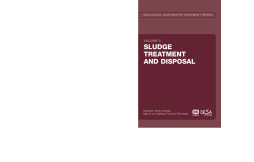
BOOK
Sludge Treatment and Disposal
Cleverson Vitorio Andreoli | Marcos Von Sperling | Fernando Fernandes | Mariska Ronteltap
(2007)
Additional Information
Book Details
Abstract
Sludge Treatment and Disposal is the sixth volume in the series Biological Wastewater Treatment. The book covers in a clear and informative way the sludge characteristics, production, treatment (thickening, dewatering, stabilisation, pathogens removal) and disposal (land application for agricultural purposes, sanitary landfills, landfarming and other methods). Environmental and public health issues are also fully described.
About the series: The series is based on a highly acclaimed set of best selling textbooks. This international version is comprised by six textbooks giving a state-of-the-art presentation of the science and technology of biological wastewater treatment. Other titles in the series are: Volume 1: Waste Stabilisation Ponds; Volume 2: Basic Principles of Wastewater Treatment; Volume 3: Waste Stabilization Ponds; Volume 4: Anaerobic Reactors; Volume 5: Activated Sludge and Aerobic Biofilm Reactors
Table of Contents
| Section Title | Page | Action | Price |
|---|---|---|---|
| Contents | vi | ||
| Preface | x | ||
| 1 Introduction to sludge management | 1 | ||
| 2 Sludge characteristics and production | 4 | ||
| 2.1 Sludge production in wastewater treatment systems | 4 | ||
| 2.2 Sludge characteristics at each treatment stage | 6 | ||
| 2.3 Fundamental relationships in sludge | 12 | ||
| 2.4 Calculation of the sludge production | 16 | ||
| 2.5 Mass balance in sludge treatment | 28 | ||
| 3 Main contaminants in sludge | 31 | ||
| 3.1 Introduction | 31 | ||
| 3.2 Metals | 32 | ||
| 3.3 Trace organics | 39 | ||
| 3.4 Pathogenic organisms | 40 | ||
| 4 Sludge stabilisation | 48 | ||
| 4.1 Introduction | 48 | ||
| 4.2 Anaerobic digestion | 49 | ||
| 4.3 Aerobic digestion | 67 | ||
| 5 Sludge thickening and dewatering | 76 | ||
| 5.1 Thickening and dewatering of primary and biological sludges | 76 | ||
| 5.2 Sludge thickening | 78 | ||
| 5.3 Sludge conditioning | 81 | ||
| 5.4 Overview on the performance of the dewatering processes | 90 | ||
| 5.5 Sludge drying beds | 92 | ||
| 5.6 Centrifuges | 99 | ||
| 5.7 Filter press | 107 | ||
| 5.8 Belt presses | 114 | ||
| 5.9 Thermal drying | 118 | ||
| 6 Pathogen removal from sludge | 120 | ||
| 6.1 Introduction | 120 | ||
| 6.2 General principles | 121 | ||
| 6.3 Mechanisms to reduce pathogens | 123 | ||
| 6.4 Processes to reduce pathogens | 127 | ||
| 6.5 Operation and control | 144 | ||
| 7 Assessment of sludge treatment and disposal alternatives | 149 | ||
| 7.1 Introduction | 149 | ||
| 7.2 Sustainable point of view | 150 | ||
| 7.3 Trends in sludge management in some countries | 150 | ||
| 7.4 Aspects to be considered prior to the assessment of alternatives | 152 | ||
| 7.5 Criterion for selecting sludge treatment and final disposal alternatives | 155 | ||
| 7.6 Sludge management at the treatment plant | 160 | ||
| 8 Land application of sewage sludge | 162 | ||
| 8.1 Introduction | 162 | ||
| 8.2 Beneficial use | 163 | ||
| 8.3 Requirements and associated risks | 169 | ||
| 8.4 Handling and management | 177 | ||
| 8.5 Storage, transportation and application of biosolids | 186 | ||
| 8.6 Operational aspects of biosolid land application | 191 | ||
| 8.7 Landfarming | 201 | ||
| 9 Sludge transformation and disposal methods | 207 | ||
| 9.1 Introduction | 207 | ||
| 9.2 Thermal drying | 208 | ||
| 9.3 Wet air oxidation | 209 | ||
| 9.4 Incineration | 212 | ||
| 9.5 Landfill disposal | 215 | ||
| 10 Environmental impact assessment and monitoring of final sludge disposal | 226 | ||
| 10.1 Introduction | 226 | ||
| 10.2 Potentially negative environmental impacts | 227 | ||
| 10.3 Monitoring indicators and parameters | 230 | ||
| 10.4 Monitoring plan | 232 | ||
| References | 237 |
